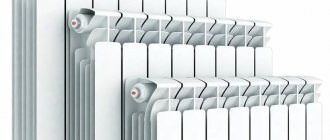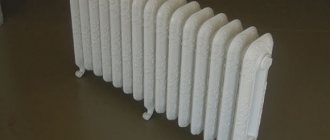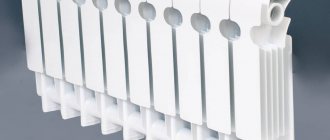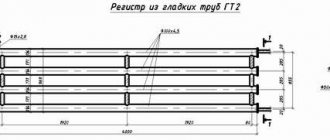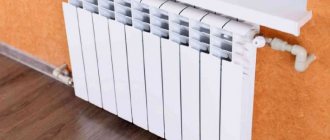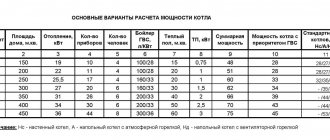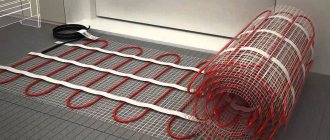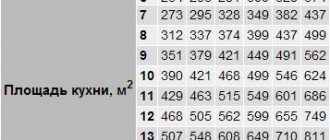How much heat is needed for heating?
To accurately calculate the required amount of heat for a room, many factors should be taken into account : the climatic features of the area, the cubic capacity of the building, possible heat loss from the housing (the number of windows and doors, building material, the presence of insulation, etc.). This calculation system is quite labor-intensive and is used in rare cases .
Basically, the calculation of heat is determined on the basis of established indicative coefficients: for a room with ceilings no higher than 3 meters, 1 kW of thermal energy is required per 10 m2 . For the northern regions, the figure increases to 1.3 kW.
For example, a room with an area of 80 m2 requires 8 kW of power for optimal heating. For the northern regions, the amount of thermal energy will increase to 10.4 kW
Heat dissipation is a key performance indicator
The heat transfer coefficient of radiators is an indicator of its power. It determines the amount of heat generated over a certain period of time. The power of the convector is influenced by: the physical properties of the device, its type of connection, temperature and speed of the coolant .
The power of the convector, indicated in its data sheet, is determined by the physical properties of the material from which the device is made, and depends on its center distance. To calculate the required number of radiator sections for a room, you will need the area of the home and the heat flow coefficient of the device.
Calculations are made using the formula:
Number of sections = S/ 10 * energy coefficient (K) / heat flow value (Q)
Example : It is necessary to calculate the number of sections of an aluminum battery (Q = 0.18) for a room with an area of 50 m2.
Calculation: 50 / 10 * 1 / 0.18 = 27.7. That is, to heat the room you will need 28 sections. For monolithic devices, instead of Q, we set the heat transfer coefficient of the radiator and as a result we obtain the required number of batteries.
If convectors are installed next to sources that affect heat loss (windows, doors), then the energy coefficient is taken from the calculation - 1.3.
Radiators are used for heating: steel, aluminum, copper, cast iron, bimetallic (steel + aluminum) , and they all have different heat flow values due to the properties of the metal.
Find out how to calculate the number of sections in bimetallic radiators?
Read here for radiator connection diagrams for a private home, how to choose the best option.
How to choose a good oil radiator for your home: tips, recommendations, benefits and harms.
Practical example of calculating thermal power
Initial data:
- A corner room without a balcony on the second floor of a two-story cinder block plastered house in a windless region of Western Siberia.
- Room length 5.30 m X width 4.30 m = area 22.79 sq.m.
- Window width 1.30 m X height 1.70 m = area 2.21 sq.m.
- Room height = 2.95 m.
Calculation sequence:
- Room area in sq.m.: S = 22.79.
- Window orientation – south: R = 1.0.
- The number of external walls is two: K = 1.2.
- Insulation of external walls is standard: U = 1.0.
- Minimum temperature – up to -35°C: T = 1.3.
- Room height – up to 3 m: H = 1.05.
- The room above is an uninsulated attic: W = 1.0.
- Frames - single-chamber double-glazed windows: G = 1.0.
- The ratio of window and room areas is up to 0.1: X = 0.8.
- Radiator position - under the window sill: Y = 1.0.
- Radiator connection – diagonally: Z = 1.0. ——————————————————————————— Total (remember to multiply by 100): Q = 2,986 Watts.
Below is a description of calculating the number of radiator sections and the required number of batteries. It is based on the obtained results of thermal power, taking into account the dimensions of the proposed installation locations of heating devices. Regardless of the results, it is recommended to equip not only window sill niches with radiators in corner rooms. Batteries should be installed near “blind” external walls or near corners that are subject to the greatest freezing under the influence of street cold.
Which heating radiators have the highest heat output?
As for the characteristics of metals, steel has the lowest heat transfer, and bimetal (a combination of aluminum and steel) has the highest.
| Material | Heat dissipation (W/m*K) |
| Steel | 47 |
| Cast iron | 52 |
| Aluminum | 202-236 |
| Bimetal | 380 |
However, these are only the properties of metals that represent the overall picture. Heat transfer, to a lesser extent, also depends on the center distance, section area, and manufacturing technology. Therefore, we recommend considering the effectiveness of each type of radiator as a whole, and then comparing the specific most successful models, choosing the most effective of them.
Bimetallic
Germanium NEO BM 350.
On average, the heat transfer rate of bimetallic radiators is the highest. Depending on the model - from 140 W to the maximum power on the market of 280 W per 1 section (model Sira RS 800). They are a combination of steel conductive channels and aluminum fins, heat up quickly and immediately release heat.
The devices are designed for system operating pressures up to 35 atm. Even the simplest models have a service life of at least 20 years. Cost per section is 395-2190 rubles.
Aluminum
Fondital Vision Innovatium 500.
The heat transfer rates of aluminum heating radiators are close to bimetallic; some expensive models may have higher power and efficiency than simple bimetallic devices.
Depending on the model, the thermal power can range from 130 W to 220.9 W per 1 section (model Roca Dubal-80). With high efficiency, they, in comparison with bimetallic ones, have many operational nuances. When choosing, you need to pay attention to the operating pressure, sometimes it does not even exceed 10 atm.
The main disadvantage is the need to maintain a certain acidity of the coolant (water), which is difficult even in a private house, not to mention an apartment with central heating. Otherwise, pH levels above 7.5 will quickly destroy the devices. The cost of 1 element is from 350 to 1200 rubles.
Steel
Stelrad Compact 22-500.
The thermal power of steel panel batteries is relatively small, but optimal, especially in terms of price-result ratio.
They heat up quickly, have better convection characteristics (the air warms up noticeably faster), but also cool down quickly. Depending on the model, the heat output is 179-13,173 W (model Kermi FTV 330930).
Calculation of the required power of radiators
The required power is calculated as follows:
- Determine the volume of the room: 6x4x2.5 = 60 m³.
- In accordance with the climatic coefficient (for central Russian regions its value is 41 W/m³): 60x41 = 2460 watts.
- Provided that winters are cold and the temperature drops to 20 degrees below zero, it is advisable to take into account a 20% power reserve. As a result, the required power is 2952 watts. Equipment of exactly this thermal power should be purchased.
There is another way to calculate the number of heating radiators correctly, based on the area of the room and correction factors.
As an example, we took one room with an area of 24 “squares” and one wall in contact with the street. The procedure for calculating heating batteries is as follows: First: 24x100x1.1 = 2640 watts, where the number 100 means standard power. In the case when the section power is 160 watts. Then you get 16.5 or 17 sections of 160 watts each (more details: “How to calculate the power of a heating radiator - we calculate the power correctly”).
Before purchasing a heating radiator, you must carefully study the technical data sheet attached to the product in order to know the minimum heat transfer value.
Usually there is no need to calculate the radiator area, since the thermal resistance or required power is determined, and then a specific model is selected from the assortment available in the retail chain. If there is a need for accurate calculations, then it would be wisest to seek help from specialists (professional
Procedure for calculating heat transfer
So, the actual power of the heating battery is much less than declared, but to select it you need to understand how much. There is a simple way to do this: applying a reduction factor to the nameplate value of the heater’s thermal power. Below is a table of coefficients by which the declared heat transfer of the radiator is multiplied depending on the actual DT value:
The algorithm for calculating the real heat transfer of heating devices for your individual conditions is as follows:
- Determine what the temperature in the house and water in the system should be.
- Substitute these values into the formula and calculate your temperature difference Δt.
- Find in the table the coefficient corresponding to the found DT.
- Multiply the rated heat transfer value of the battery by it.
- Calculate the number of sections or entire heating devices to heat the room.
In the example given, the thermal power of 1 section of a bimetallic radiator will be 200 W x 0.48 = 96 W. To heat a room of 10 m² it will take approximately 1000 W of heat or 1000/96 = 10.4 ≈ 11 sections (we round up).
The presented table and calculation of the heat transfer of batteries should be used when the documentation indicates Δt equal to 70 °C. But it happens that manufacturers provide radiator power for other conditions, for example, at Δt = 50 °C. Then you can’t use coefficients; it’s easier to dial the required number of sections according to the passport characteristics, just take their number with a margin of one and a half.
Reference. Many manufacturers indicate heat transfer values under the following operating conditions: t = 90 °C, t = 70 °C, t = 20 °C, which exactly corresponds to Δt = 50 °C.
Adjusting results
In order to obtain a more accurate calculation, you need to take into account as many factors as possible that reduce or increase heat loss. This is what the walls are made of and how well they are insulated, how large the windows are and what kind of glazing they have, how many walls in the room face the street, etc. To do this, there are coefficients by which you need to multiply the found values of heat loss in the room.
The number of radiators depends on the amount of heat loss
Window
Windows account for 15% to 35% of heat loss. The specific figure depends on the size of the window and how well it is insulated. Therefore, there are two corresponding coefficients:
- ratio of window area to floor area: 10% - 0.8
- 20% — 0,9
- 30% — 1,0
- 40% — 1,1
- 50% — 1,2
- three-chamber double-glazed window or argon in a two-chamber double-glazed window - 0.85
Walls and roof
To account for losses, the material of the walls, the degree of thermal insulation, and the number of walls facing the street are important. Here are the coefficients for these factors.
Thermal insulation level:
- brick walls two bricks thick are considered the norm - 1.0
- insufficient (absent) - 1.27
- good - 0.8
Presence of external walls:
- interior space - no losses, coefficient 1.0
- one - 1.1
- two - 1.2
- three - 1.3
The amount of heat loss is influenced by whether the room is located on top or not. If there is a habitable heated room on top (the second floor of a house, another apartment, etc.), the reduction factor is 0.7, if there is a heated attic - 0.9. It is generally accepted that an unheated attic does not affect the temperature in any way (coefficient 1.0).
It is necessary to take into account the characteristics of the premises and climate in order to correctly calculate the number of radiator sections
If the calculation was carried out by area, and the ceiling height is non-standard (a height of 2.7 m is taken as the standard), then a proportional increase/decrease using a coefficient is used. It is considered easy. To do this, divide the actual ceiling height in the room by the standard 2.7 m. You get the required coefficient.
Let's do the math for example: let the ceiling height be 3.0m. We get: 3.0m/2.7m=1.1. This means that the number of radiator sections that was calculated by area for a given room must be multiplied by 1.1.
All these norms and coefficients were determined for apartments. To take into account the heat loss of a house through the roof and basement/foundation, you need to increase the result by 50%, that is, the coefficient for a private house is 1.5.
Climatic factors
Adjustments can be made depending on average winter temperatures:
- -10°C and above – 0.7
- -15оС — 0.9
- -20оС — 1.1
- -25оС — 1.3
- -30оС — 1.5
Having made all the required adjustments, you will receive a more accurate number of radiators required to heat the room, taking into account the parameters of the premises. But these are not all the criteria that influence the power of thermal radiation. There are also technical subtleties, which we will discuss below.
Comparison by thermal power
If you carefully studied the previous section, you should understand that heat transfer is greatly influenced by air and coolant temperatures, and these parameters depend little on the radiator itself. But there is a third factor - the heat transfer surface area, here the design and shape of the product plays a big role. It is impossible to clearly compare a steel panel heater with a cast iron radiator; their surfaces are too different.
It is difficult to compare the heat output of flat panels and ribbed surfaces of complex configurations
The fourth factor influencing heat transfer is the material from which the heating device is made. Compare for yourself: 5 sections of the GLOBAL VOX aluminum radiator with a height of 600 mm will deliver 635 W at DT = 50 °C. A cast iron retro battery DIANA (GURATEC) for 5 sections of the same height will transmit only 530 W to the room under similar conditions (Δt = 50 °C). These data are published on the manufacturers' official websites.
Note. The power characteristics of aluminum and bimetallic heaters differ little; there is no point in comparing them.
You can try to compare aluminum with a steel panel radiator by taking the closest standard size that fits the dimensions. The length of a battery of 5 GLOBAL aluminum sections with a height of 600 mm will be approximately 400 mm, which corresponds to a KERMI 600 x 400 steel panel.
The table shows the thermal performance of 1 section made of aluminum and bimetal depending on the size and temperature difference Δt
Even if we take a three-row steel panel (type 30), we get 572 W at Δt = 50 °C versus 635 W for 5-section aluminum. Also keep in mind that the GLOBAL VOX radiator is much thinner, the depth of the device is 95 mm, and the KERMI panels are almost 160 mm. That is, the high heat transfer of aluminum sections makes it possible to reduce the dimensions of the heater.
In an individual heating system for a private home, batteries of the same power, made of different metals, will work differently. Therefore, the comparison is quite predictable:
- Bimetallic and aluminum products quickly heat up and cool down. By giving off more heat over a period of time, they cool the water returned to the system more.
- Steel panel radiators occupy a middle position, as they transfer heat less intensively. But they are cheaper and easier to install.
- The most inert and expensive are heaters made of cast iron; they are characterized by long heating and cooling, which causes a slight delay in the automatic regulation of coolant flow by thermostatic heads.
Types of heating devices
Batteries are used to transfer heat from heated water to the surrounding area. The operating principle of the products is based on the use of materials as heaters that are capable of taking energy from the coolant and transferring it in the form of heat radiation. Therefore, one of the main characteristics of a radiator is transmission efficiency.
The efficiency of radiators is affected by the material and shape of the sections
In addition to the material used, this characteristic is also influenced by the design features of the products. They must take into account that warm air, due to its rarefied state, is lighter than cold air. Passing through the heating radiator, it heats up and rises, drawing in a portion of cold air, which also heats up.
Before calculating the number of radiators per room, you should decide on the type of battery.
There are several options that differ in appearance, shape of sections and material used to create the product. Modern batteries, depending on the material used for their manufacture, are divided into the following types:
- cast iron;
- aluminum;
- steel;
- bimetallic;
- copper;
- plastic.
Modern radiators can consist of different metals, and also contain several types of metals.
In addition to heat transfer, an important parameter is the ability of radiators to withstand the required pressure created in the heating system. Thus, when heating a multi-storey building, a pressure of about 8-9.5 atmospheres is considered normal. But when the circuit is built incorrectly, it can drop to 5 atmospheres. For two-story buildings, the optimal indicator is considered to be 1.5−2 atmospheres. The same value is acceptable for private households.
If the battery is designed for less pressure and a hydraulic shock occurs in the circuit, it will simply rupture with all the ensuing consequences. Therefore, preference is most often given to cast iron, aluminum and bimetallic structures.
Cast iron products
Cast iron radiators resemble an accordion in appearance. They are distinguished by simplicity of design and accuracy . Today they are especially popular among designers when creating retro style. Cast iron batteries are characterized by low thermal conductivity: in order to warm the radiator to +45°C, the carrier temperature must be about +70...+80°C. The devices are mounted on reinforced brackets or mounted on special legs.
Cast iron batteries have fairly low thermal conductivity, but take a long time to cool down
Batteries of this type are assembled from sections that are connected to each other using a key. The connection points of the parts are carefully sealed with paronite or rubber gaskets. As a rule, one section of a modern radiator has a thermal power of about 140 W (versus 170 W of the Soviet model). One section holds about one liter of water.
The advantages of cast iron are that it is not subject to corrosion, so it can be used with water of any quality.
The service life of the device is about 35 years. No special care is needed for this type of battery. Cast iron batteries take a long time to heat up, but at the same time they take a long time to cool down. They can easily withstand pressure of 12 atmospheres. On average, one section can heat from 0.66 m² to 1.45 m² of area.
Aluminum heater
There are two ways to make aluminum batteries - casting and extrusion . The first type of device is made in the form of a single piece, and the second - sectional. Cast batteries are designed for use at a pressure of 16-20 atmospheres, and extruded ones - from 10 to 40 atmospheres. Preference is given to cast radiators due to greater reliability.
Aluminum radiators have good thermal conductivity, but are susceptible to rapid contamination
The heat transfer of the battery, according to the manufacturers, can reach 200 W at a carrier temperature of +70°C. In practice, when the coolant is heated to +50°C, an aluminum section measuring 100 x 600 x 80 mm heats about 1.2 m³, which corresponds to a heat transfer of 120 W. The volume of one section is about 500 ml.
It should be noted that such heaters are sensitive to the quality of the coolant and quickly become dirty with the risk of gas formation. When installing them, a water purification system must be provided.
Recently, aluminum models have appeared on the market that use anodic oxidation treatment. This makes it possible to virtually eliminate the occurrence of oxygen corrosion.
Bimetallic structures
Bimetallic radiators are assembled from steel pipes and aluminum panels. Due to the use of aluminum, they are characterized by high heat transfer. This type of battery is durable and has a service life of about 20 years. At a coolant temperature of +70°C, the average heat transfer is 170−190 W. Such a device can withstand pressure up to 35 atmospheres.
This type of radiator contains two types of metals and combines their properties
Bimetallic radiators are available with different center distances: 20, 30, 35, 50, 80 cm. This allows them to be built into various niche shapes, even completely square ones. Sections can be assembled in any quantity, and they are completely identical on the left and right.
To protect against corrosion, the internal pipes are coated with polymers. They are not subject to electrochemical corrosion. Such radiators are not afraid of water hammer and high temperatures. Therefore, bimetallic radiators are products with the best performance provided by the aluminum casing, they are strong, durable and stable due to the internal steel structure.
Their only drawback is their high price.
Comparison by other characteristics
One feature of battery operation – inertia – has already been mentioned above. But in order for the comparison of heating radiators to look objective, in addition to heat transfer, other important parameters should be taken into account:
- working and maximum coolant pressure;
- amount of water held;
- weight.
The operating pressure limitation determines whether the heating device can be installed in multi-storey buildings, where the height of water lifting by network pumps can reach hundreds of meters. The parameter does not matter for private houses, where the pressure in the system is low, maximum 3 Bar.
Comparing the capacity of radiators can give an idea of the total amount of water in the network that will have to be heated. Well, the weight of the product is important when choosing the installation location and method of attaching the battery.
As an example, below is a comparison table of the characteristics of various heating radiators of the same size:
Note. In the table, a heating device consisting of 5 sections is taken as 1 unit, except for the steel one, which is a single panel.
Steel panel radiators
The design of a panel steel radiator is based on two steel plates connected by welding (thickness from 1.25 to 1.5 mm). The recesses stamped into them form collectors and connecting channels. There is a wide selection of steel radiators in height (from 200 to 900mm) and length (from 400mm to 3m).
Panel radiators are characterized by optimal heat transfer due to fins and a larger panel area. This gives the room coziness and additional comfort. Another advantage of heating devices is their relatively low cost compared to radiators of other brands, although the operating efficiency does not suffer at all from this.
Steel panel radiators also have disadvantages, among which low operating pressure and flooding in the central heating system should be noted. With a water hammer pressure of more than 13 atmospheres, the device can swell and even burst. The same can happen if water is drained from the risers in the summer, since the radiator is afraid of draining the coolant. To avoid such troubles, you cannot install the device in a central heating system. Remember that, despite all the strength of the structure, the radiator is susceptible to corrosion, and if this process begins, it will be almost impossible to stop it. To avoid this, do not drain the water from the device for a long period of time (more than two weeks), otherwise air will get into it.
Devices with predominantly convection radiation. These radiators have the following advantages: a large number of standard sizes, good value for money, attractive appearance, high heat transfer per unit volume, they are well regulated by radiator thermostats, and have low thermal inertia. The main disadvantage is that they cannot tolerate draining the coolant, they do not like open heating systems and systems that use pipes that are unstable to the diffusion of oxygen in the air (for example, some types of polypropylene pipes), these radiators cannot withstand hydraulic shocks from poor quality coolant, which practically blocks their way into the existing urban development.
In Russian conditions, such radiators are ideally suited for cottage construction with autonomous boiler houses, because they are not designed for very high pressure, but this is not necessary, since in a country house there should not be high pressure in the system. Steel panel radiators have a relatively low thermal inertia, which means they make it easier to automatically regulate the temperature in the room. They can also be used in multi-storey buildings with autonomous heating units.
There are two types of panel radiators: with bottom connection and with side connection. Bottom-connected radiators have a built-in thermostatic valve on which a thermostat can be installed to maintain the set temperature in the room. As a result, the cost of radiators with bottom connections is higher than their counterparts with side connections.
Features of connecting radiators
Connecting batteries to the heating system is of great importance only with natural circulation .
In this case, the principle is that all radiators are completely filled with coolant and do not form counter currents. But when using forced circulation, this factor does not matter.
How to calculate how many sections are needed?
To heat all the rooms, you will need to know the power that will be required for each room, only after this will you calculate the heat transfer of the battery. Calculating the heat that will be required to heat the room is necessary in order to find out how many sections the radiator should consist of.
To determine how much heat is required to heat a room, a fairly simple formula is used. Based on the location, the amount taken is the amount of heat that is required per 1m3 of the room; for the south side this value will be 35 W/m3 and 35 W/m3 for the north. Thus, the volume of the required room is reduced by one of the values and as a result we find out the required power.
To calculate the power of bimetallic or aluminum batteries, you need to take into account the parameters specified by the manufacturer in the passport. Based on these data, for one section of the battery at DT = 70. This indicates what the heat flow is equal to at a supply temperature of 105 ºС, and at a return temperature of 70 ºС. This is taking into account that the temperature inside the room will be about 18ºC.
Based on the data in our table, for a bimetallic radiator, one section with an interaxial size of 500 mm is 204 W, but taking into account the fact that the coolant temperature in the supply will be 105ºC.
Power calculation. Current systems, especially individual ones, do not heat the coolant that much, which means that the heat flow will be less. To obtain real values, it is necessary to calculate the DT characteristic for specific conditions using the formula:
DT = (tflow + trev) / 2 – troom,
where: tpod – water temperature in the supply pipeline; tobr - the same, in the return; troom – temperature inside the room.
After this, the heat transfer indicated in the product passport must be multiplied by a correction factor, which is taken in accordance with the DT values according to the table:
For example, the coolant temperature is 80/60°C, the temperature in the room will be 21°C, the DT characteristic will be equal to (80 + 60) / 2 – 21 = 49, the correction factor will be 0.63. In this case, the heat flux from one section of the same bimetallic radiator will be equal to 204 * 0.63 = 128.5 W. Based on these data, the required number of sections is selected that will warm the room well.
Calculation of different types of radiators
If you are planning to install sectional radiators of a standard size (with an axial distance of 50 cm in height) and have already chosen the material, model and desired size, there should not be any difficulties in calculating their number. Most reputable companies that supply good heating equipment have on their website the technical data of all modifications, including thermal power. If it is not the power that is indicated, but the coolant flow rate, then it is easy to convert to power: the coolant flow rate of 1 l/min is approximately equal to the power of 1 kW (1000 W).
The axial distance of the radiator is determined by the height between the centers of the holes for supplying/removing coolant.
To make life easier for customers, many websites install a specially designed calculator program. Then the calculation of heating radiator sections comes down to entering data on your premises in the appropriate fields. And at the output you have the finished result: the number of sections of this model in pieces.
The axial distance is determined between the centers of the coolant holes
But if you’re just evaluating possible options, then it’s worth considering that radiators of the same size made of different materials have different thermal power. The method for calculating the number of sections of bimetallic radiators is no different from calculating aluminum, steel or cast iron. Only the thermal power of one section can be different.
To make it easier to calculate, there are averaged data that you can use as a guide. For one radiator section with an axial distance of 50 cm, the following power values are accepted:
- aluminum - 190W
- bimetallic - 185W
- cast iron - 145W.
If you are just figuring out which material to choose, you can use this data. For clarity, we present the simplest calculation of sections of bimetallic heating radiators, which takes into account only the area of the room.
When determining the number of heating devices made of bimetal of a standard size (center distance 50 cm), it is assumed that one section can heat 1.8 m2 of area. Then for a room of 16 m2 you need: 16 m2/1.8 m2 = 8.88 pcs. Let's round up - we need 9 sections.
We calculate similarly for cast iron or steel bars. All you need is the following rules:
- bimetallic radiator - 1.8m2
- aluminum - 1.9-2.0 m2
- cast iron - 1.4-1.5 m2.
This data is for sections with an interaxial distance of 50 cm. Today, there are models on sale with very different heights: from 60cm to 20cm and even lower. Models 20cm and below are called curb. Naturally, their power differs from the specified standard, and if you plan to use a “non-standard”, you will have to make adjustments. Either look for passport data, or do the math yourself. We proceed from the fact that the heat transfer of a heating device directly depends on its area. As the height decreases, the area of the device decreases, and, therefore, the power decreases proportionally. That is, you need to find the ratio of the heights of the selected radiator with the standard, and then use this coefficient to correct the result.
Calculation of cast iron heating radiators. Can be calculated by area or volume of the room
For clarity, we will calculate aluminum radiators by area. The room is the same: 16m2. We count the number of sections of standard size: 16m2/2m2=8pcs. But we want to use small sections with a height of 40 cm. We find the ratio of radiators of the selected size to standard ones: 50cm/40cm=1.25. And now we adjust the quantity: 8pcs * 1.25 = 10pcs.
Which radiators have the best heat transfer?
As can be seen from the table below, which compares the heat transfer of heating batteries, bimetallic heating radiators have the highest power. They are a ribbed aluminum body, inside of which there is a durable welded frame made of metal tubes designed for the flow of coolant.
This type of heating equipment is perfect for installation in a private house with an individual system, as well as for a centralized heating system. The main disadvantage of such products is their high cost. However, the best heat transfer of bimetallic heating radiators often allows you to make a choice in their direction.
Additional factors affecting heat transfer
This indicator is also affected by:
- Connection type.
- Features of accommodation.
The radiator can be connected in the following ways:
Most manufacturers believe that the owner will make
a diagonal connection, because it is the most effective. It consists of connecting the inlet pipe to the pipe located at the top of the heating device, and connecting the outlet pipe to the pipe located at the bottom of the opposite end. Thanks to this, the coolant can easily fill all sections and transfer heat to every particle of the heating radiator. In this case, it is not necessary to create very high pressure to move water or other heated liquid.
Lateral connection involves connecting pipes to the same section. The inlet pipe is located at the top, the outlet pipe at the bottom.
This leads to poor heating of the last ribs. According to statistics, heat loss is 7%. The lower connection diagram results in 20% losses. Heat transfer losses in the last two connection schemes to a heating device can be minimized by using forced circulation of heated liquid. Even a small pressure is enough to completely warm up all sections.
Battery placement is very important. If it is installed crookedly, air pockets will form in some sections. Heat transfer will be less.
The loss of heat transfer can be like this:
- 7-10% - if the permissible distance between the device and the window sill is exceeded. It should be 10-15 cm;
- 5% - if the distance between the wall and the battery is reduced. The optimal size is 3-5 cm;
- 7% - in a situation where the distance between the floor and the radiator is not maintained. It should be 10-15 cm.

